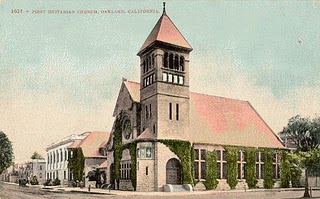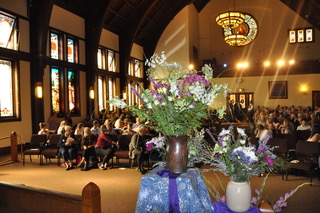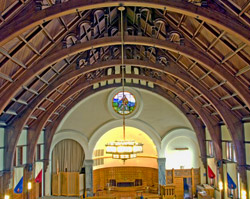Our Historic Building

- Opened in 1891
- Renovated and retrofitted in 1996-98 (East Wing and Wendte Hall), 2009 (Hamilton Hall)
- National Register of Historic Places (NPS-77000284)
- California Historic Landmark #896
- Architect: Walter J. Mathews
- Architectural Style: Richardsonian Romanesque
For more than a century, First Unitarian Church of Oakland has stood on the corner of 14th and Castro Streets in downtown Oakland as a beacon of liberal religious acceptance, tolerance and social activism.
Today, it houses a vibrant and growing multiracial, multicultural, multigenerational congregation of more than 400 children, men, women and transgender people. The 2009 renovation and earthquake retrofit of the historic Hamilton Hall sanctuary completes a 20-year effort to upgrade and safeguard this religious and cultural landmark.
Original Construction

Photo by Steve Thomasberger
The church was built on land purchased from Jane Sather, a prominent Oaklander and church member who was instrumental in the creation of the University of California at Berkeley. Berkeley’s famed Campanile tower, formally known as Sather Tower, was modeled on the 84-foot steeple of First Unitarian Church.
Built in 1890-1, First Unitarian Church of Oakland was designed by future Oakland City Architect Walter J. Mathews in the Richardsonian Romanesque style popularized by East Coast architect Henry Hobson Richardson. This architectural genre is characterized by semicircular arches, use of stone and other rough exterior surfaces, and dynamic interior spaces. Though not designed by Richardson, the church bears a striking resemblance to Richardson’s East Coast landmark buildings and is one of the earliest examples of this unique architectural style on the West Coast.
With the exception of the famous stained glass windows (produced by Goodhue of Boston), only materials from California were used in the original construction, most notably the dramatic redwood arches in Hamilton Hall, which were built of first growth redwood harvested from the Oakland/Berkeley hills. At that time, these redwood arches formed the widest span in any building west of the Mississippi.
The general contractor was Peter N. Remillard, whose family name can still be seen on some of the almost 100,000 bricks used in this building. All of the construction materials, including 500 blocks of sandstone, marble, 175 tons of granite, terra cotta, plaster, hardware, lumber and slate, were manufactured, quarried or timbered in California.
The marble pillars at the front of the sanctuary, 12 feet high, 2½ feet in diameter, are thought to be the largest single blocks of marble ever quarried in California. They were purchased at a cost of $1,000 with a gift from Mrs. William Norris, the widow of Rev. Thomas Starr King, the famous Unitarian minister and orator.
The Castro Street side of the church, now bordering the Interstate 980 freeway, was originally lined with hitching posts, as many congregants came to church by horse-drawn carriage. The church was lit at night by electric lights and gas jets.
Role in the Community
From the beginning, First Unitarian Church has played an important role in the life of Oakland and the East Bay – and the world. The poet Joaquin Miller was one of the original members of the congregation, along with the families of writer Jack London and Jane Sather. President William Howard Taft, essayist Ralph Waldo Emerson and abolitionist Julia Ward Howe all spoke in the sanctuary.
Swami Vivekananda, who is regarded as a modern saint of India, spoke at the church on February 25, 1900, while on a visit to Northern California. To this day, members and followers the Vedanta Society regard Hamilton Hall as a shrine.
In 1904, the Pacific Unitarian School for the Ministry held its first classes at the church. Later renamed the Starr King School for the Ministry, the seminary is the leading Unitarian Universalist teaching institution on the West Coast.
In 1945, the church was used for the organizing meetings for the United Nations, including the formation of the United Nations Educational, Scientific and Cultural Organization (UNESCO).
In the 1950s, as redevelopment swept the nation and Oakland, the 980 freeway was drawn to be located about 1/8 of a mile east of where it is today, which is to say directly through Hamilton Hall. But the congregation, with help from historic preservationists, succeeded in having the freeway plan changed and in having the church designated as a California Historical Landmark.
Throughout its history, the church has played a dynamic and changing role in the community. The Oakland Interfaith Gospel Choir and the Children’s Express newspaper project were born at the church. Following the 1989 Loma Prieta Earthquake, the church building was used as an emergency homeless shelter.
Modern Earthquake Retrofit and Renovation

Also after the 1989 quake, the unreinforced masonry building was deemed seismically unsafe. The Oakland Heritage Alliance, a local preservation non-profit, lobbied for saving the church as one of Oakland’s most significant historic buildings. The OHA, the Planning Commission, and others assisted the church in qualifying for FEMA funds for seismic upgrade, historic restoration and renovation of the East Wing and Wendte Hall. From 1996 to 1998, the building was closed for a $6.1 million renovation and the congregation worshipped temporarily at First Baptist Church on Telegraph Avenue.
Due to funding constraints, Hamilton Hall was not included in the first phase of retrofit and renovation, though the congregation was permitted to move back in after the initial round of renovations. The congregation struggled to raise the needed funds to retrofit and restore the sanctuary, and in 2009 succeeded in raising private contributions to fund the work. The restoration and renovation of Hamilton Hall was complete in 2010, allowing this historic building to continue to serve the ever changing needs of the congregation, neighborhood, and city of Oakland.
